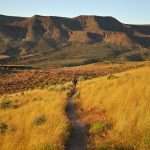By Michael McDowell, Newsletter Editor, Trailkeepers of Oregon In early May, John Sparks and Michael McDowell sat down for a discussion with Connie Soper, author of Exploring the Oregon Coast Trail: 40 Consecutive Day Hikes from the Columbia…
By Michael McDowell, Newsletter Editor, Trailkeepers of Oregon
On November 4, 2019, John Sparks and Michael McDowell interviewed longtime TKO trail crew leaders Elaine and Pat Keavney at their home on a hillside outside Oregon City.
How did you get into trail work?
Pat: 9/06/08. Elaine and I went on a weeklong with WTA [Washington Trails Association] up in the northern part of Washington, north and east of Winthrop. I had been a scoutmaster and assistant scoutmaster for 20 years and went camping with the boys. I was getting ready to step down and I wanted something that Elaine and I could do that was still related to camping and being out. We’d been members of WTA since about 1996 for their newsletter so I’d know where I could take the boys. We decided we’d try a weeklong vacation. And we got hooked. We did only weeklong trail work parties. After we moved down here from Puyallup in 2010 we were still doing weeklongs with WTA. We didn’t even know there was an organization in Oregon.
Elaine: We went to Trail Skills College in Cascade Locks, and Curtis [Smith, head crew leader and former TKO board member] had a TKO booth.
Pat: He said, “You guys live in Oregon? You need to be working with me.”
Elaine: He talked to us about TKO, and we said, “Let’s see what we can do.” So that’s how we got started moving over to this side of the river.
Pat: Elaine worked with Curtis more than I did. He said, “You know what you’re doing,” and asked Elaine if she would become a crew leader, and would we take on the stewardship of the Clackamas River Trail. We did and started leading crews. She had done a couple of things up around Mount Hood with him, and I worked with Curtis when I could. We loved it. By this time we had 25 days with WTA under our belts, and we thought we were the cat’s meow. We get over to southwest Washington and I’m telling people how to do this and how to do that, and they said “Pat, you’re not in charge.” And I suddenly realized that these guys had worked as much as I had, or more. Now I have 300 days with WTA.
Elaine: I have about 225.
Pat: We’ve each done over 300 work parties with TKO, or close to it. We did Tuesdays and Thursdays for a year. We were doing just over 50 days in each state. And then we boomed in TKO–there were weeks at McIver State Park when we worked all five days.
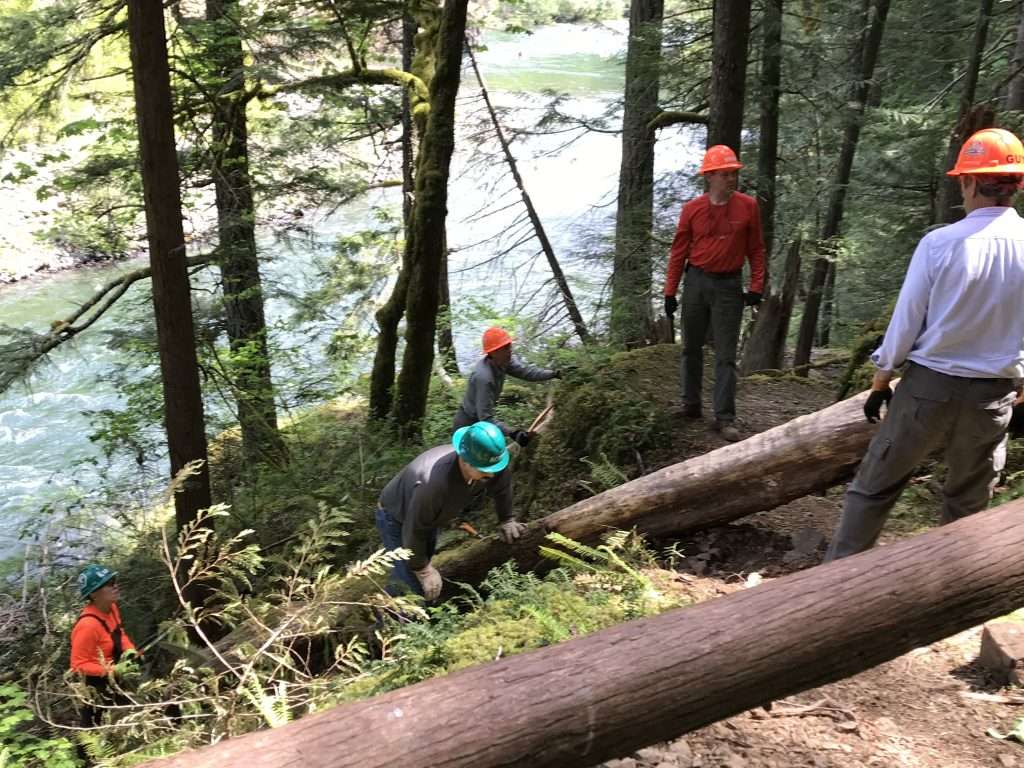
C-sawyer Pat Keavney and B-sawyer Guy Hamblen teach new A-sawyers about the complexities of a C-level log on a steep hillside along the Clackamas River Trail. (Photo by Elaine Keavney)
Tell us about the Keavney team. Pat has talked on trail work parties about how you complement each other.
Elaine: He’s the technical guy. I think that’s part of it. In a way it’s a real advantage but in a way it’s a weakness, because I don’t have to learn the technical stuff. We are
always together. He says I’m better at looking at a trail and knowing that kind of stuff. I have better trail eyes, probably.
Pat: And working with people. She’s much better at working with people than I am.
Elaine: We complement each other when we do new trail work because we see it so differently. He’s much more linear. I’m right-brained, he’s left-brained. He’s very detail-oriented. So when it comes to doing these technical things, like how to build a bridge–
Pat: And like the rigging. In the Boy Scouts I had to be certified. If a Boy Scout is six feet off the ground, he has to be rigged with a safety harnesses on. So I learned how to
do the overhead cabling, with pulleys and all of that, only for human weight, not for thousand-pound logs. When I took the course with PCTA [Pacific Crest Trail Association] for high rigging, I go, “I know all that.” I didn’t learn anything new except some of the physics. It’s the same stuff at a different scale.
Elaine: I think we both are good teachers. He’s much better teaching one-on-one. He loves to do that. It’s easier for me to take a whole group of people, and walk down a trail and say, why don’t we do it this way here, why don’t we do it that way there. My brain is much more wired to the big picture. And his is not.
Pat: If each of you is working on three different segments, and I’m focused on this one, and then you ask me a question, it disrupts everything. I prefer to be in a small group.
Elaine: He really has to close one door to move to the next. It’s the way he’s wired.
Pat: I love saw teams. A saw team is three people. I can wear a yellow hat [of a crew leader] if I have to, but I’m more comfortable working behind the scenes.
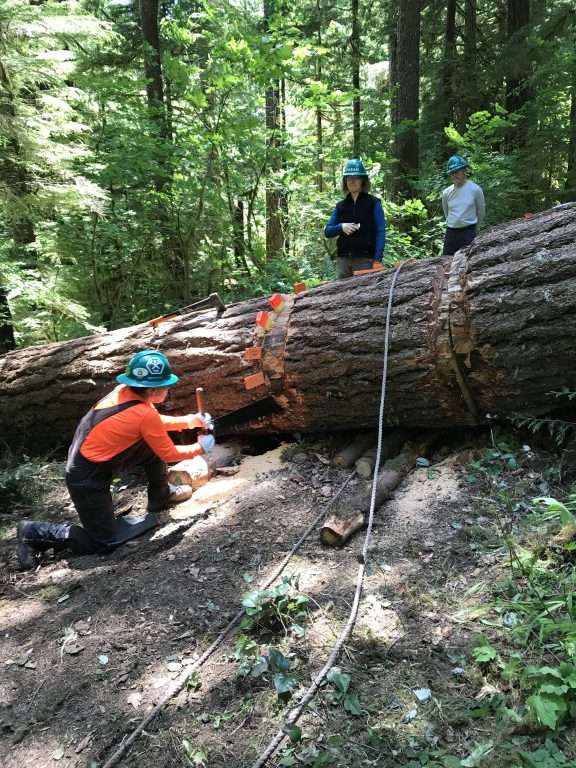
TKO volunteers Kim Kovacs and Jane Kauth (not visible on the other side of the log) use a six-foot saw to cut a section from a 44-inch-in-diameter Douglas fir on the Clackamas River Trail in June 2019. (Photo by Elaine Keavney)
Elaine, tell us about your role on the TKO board and how that connects to your trail work.
Elaine: It’s funny how I got on the board. I went to the board initially when it was smaller, before the fire–everything is “before the fire”–because we were doing a lot of work over here, at McIver, that no one else knew about. So I started coming to the meetings just to report, so that those on the board would know what we’re doing over here in Clackamas County. Curtis sent me an email saying, “Why don’t you just get on the board? You’re coming to every meeting anyway.” And so that’s how I got started. I currently chair the Stewardship Committee. I want to help grow the stewardship portion of TKO, so that there’s something in the strategic planning that allows the crew leaders to get the training they need, and to be sure that there are enough trails, that the trails are maintained, and that the volunteer base continues to grow. Steve [Kruger, TKO executive director] had the idea to give the crew leader team, which meets monthly, the opportunity to provide input to the board through me as the Stewardship Committee chair. I get ideas from the crew leaders, who are out on the trails and have boots on the ground, about what they think they would need for their own safety or about things that might require board input, and then take that information back to the board. And I let the crew leaders know what’s going on at the strategic planning level on the board. I’m the liaison.
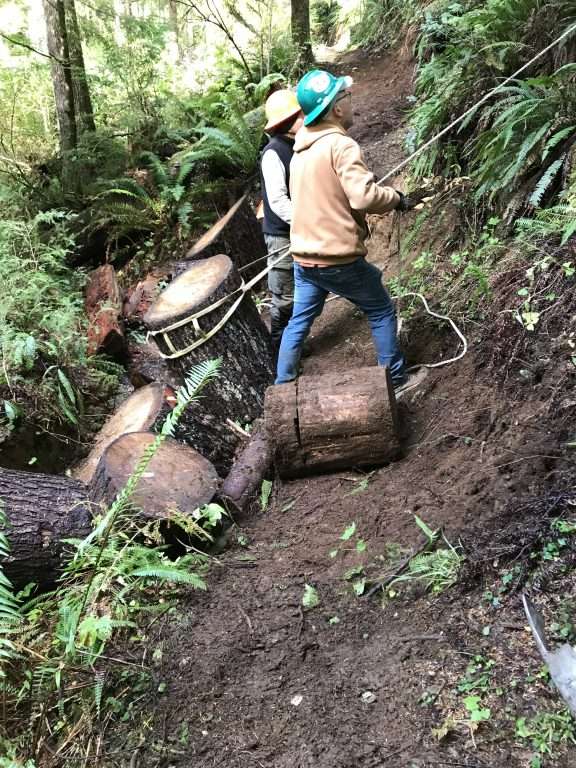
TKO volunteers Sid Bos and Elaine Keavney work with a rope puller to move a log section into a more vertical position to form a curb wall against which dirt can be added to raise the tread on the Cascade Head Trail in October 2019. (Photo by Pat Keavney)
You’ve worked for years with WTA, which of course is a much more experienced organization than TKO. What would you say working with WTA has given you? It’s given you basic skills at trail work–
Elaine: At the board level, too. As our organization has grown, we’ve been able to use the knowledge of how WTA works. Networking is huge. Steve [Kruger] and Ryan [Ojerio, WTA Southwest Regional Manager] know each other well, and Pat and I know people who work the trails week after week. We’ve traded knowledge and information back and forth. WTA had only grip hoists, for example, to move heavy logs and rocks. They didn’t have rope pullers.
Pat: One time we took a rope puller to the Washington coast and we pulled gorse.
Elaine: In Washington they said, “We need one of these!” And now they have one.
Pat: They started recognizing that it was a lighter option that was a lot easier to work with.
Elaine: So we help each other. A thing that has been so nice since the fire is that now there’s a crossover. There are people from Washington coming to Oregon and people from Oregon going to Washington to do trail work. The Gorge is everyone’s. It doesn’t matter which side of the river you live on.
Pat: As we were trying to develop our program, we copied everything from WTA. Curtis used their crew manual as a template to make our manual, with their permission.
Elaine: Our safety check list is exactly the same. With permission, of course.
Pat: Another thing: PCTA has good training for each class. We have permission to use that as well. We basically copied the saw program of Back Country Horsemen of Washington, with their permission. We’re not trying to remake the wheel. We’re taking the best of everything. The only thing that we’ve done that’s truly different is the hats. Our hats have our names in the front because Pat Keavney does not remember names. We had all the hats in the beginning and we put the names on the front instead of the side so I don’t have to walk around you to remember who you are.
Elaine: It’s not just WTA. We’ve all interfaced well together. There hasn’t been really any competition to speak of. We’re all about trails.
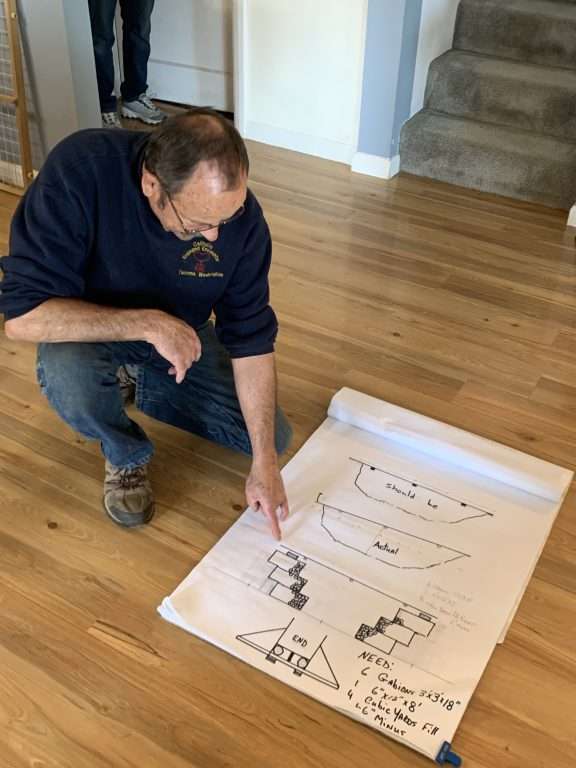
Pat Keavney shows his design for gabions to be used for bridge support at McIver State Park. (Photo by Michael McDowell)
What is one of your completed TKO projects that you want to highlight?
Elaine: The Viewpoint Trail at McIver.
Pat: That was the first time that Elaine and I were able to design and lead. If you start at the top, just after you cross the bridge, if you’re going in that clockwise direction, you can look down and see where we built trail way down there. But it was so steep that we fell down when the rain started. We went back to the rangers and said, this is not sustainable. We can’t build it. It’s too steep. They let us move it. And we said it was still going to be too steep. We moved it from the original that the rangers wanted, up higher, and now the third route is the final one. We had worked on new trail construction in Washington about ten years ago, but we weren’t leaders. This was the first new trail construction project that Elaine and I led. We did the first 2,000 feet of new trail at McIver, and we’ve since added another 1,500 feet to that to connect to the Vortex Trail.
Elaine: We’re proud of the Viewpoint Trail because we learned so much. It was 2016/17, when it rained and rained and rained, then snowed for fifteen days and the kids never went to school. We’ve said to many people that if we had built it this year, it would not be as good as it is. It would not be as sustainable. We built it for the worst conditions. And it’s a great trail. I love to walk on that trail because I know that it’s going to hold up.
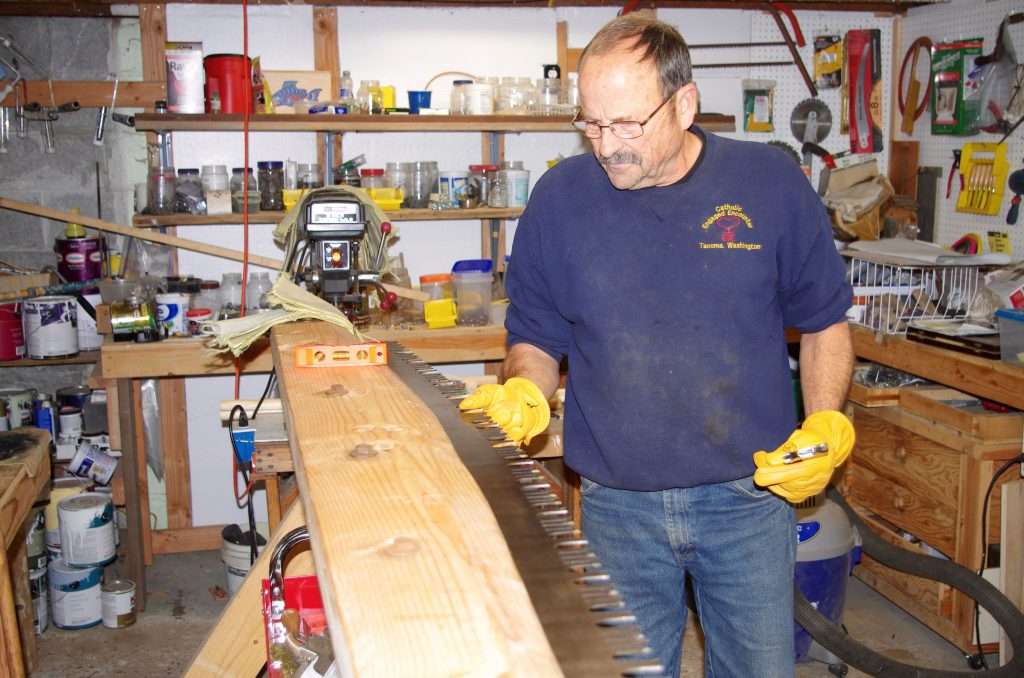
Pat Keavney with a six-foot crosscut saw blade clamped in a vise for sharpening. (Photo by John Sparks)
Is there any project you’re looking forward to? What’s in the pipeline?
Elaine: Cascade Head. The trail was closed for eleven years. It’s 2.3 miles. It’s part of the Oregon Coast Trail. You go up Cascade Head from the south, on the Lincoln City side, and up on the top, there’s a US Forest Service road, and we’re working on the north side of it. The trail’s closed because there was so much damage. When people are hiking the Oregon Coast Trail, they have to hike down a mile, down the Forest Service road, and then hike on the highway into Neskowin.
Pat: The Forest Service came in a year ago and used their fire crews just to see if this trail was even there anymore. It hadn’t been looked at for eleven years. They came in with a chainsaw crew and did a lot of cutting. And then we started working in March. The first weekend we cut and removed a hundred trees off the trail. We’ve cut a few more as needed.
Elaine: Our goal for this year has been to get it so that it’s opened, safe to hike, down all the way to the bottom, which ends at Highway 101.
Pat: You have safe passage from top to bottom now. It’s not finished tread, because we want to take it out to 24-inch complete, with everything shaped. Our goal is to have safe passage this year, and finished tread next year. It will hopefully open next year.
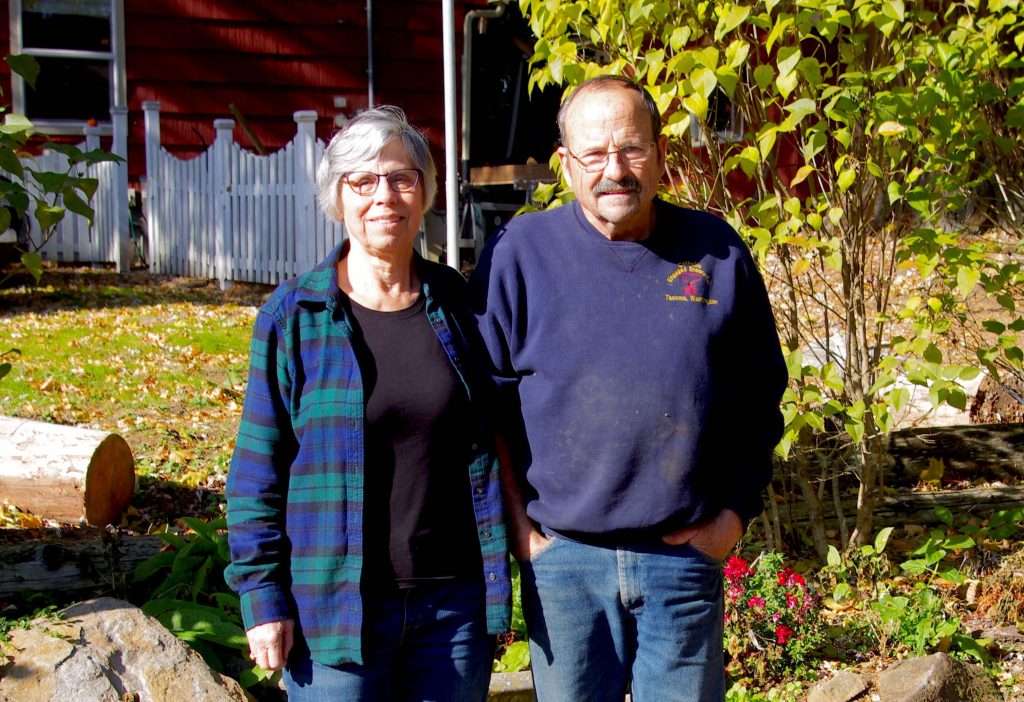
Elaine and Pat Keavney at home with Pat’s crosscut test log in the background. (Photo by John Sparks)
Michael McDowell: michael.mcdowell@trailkeepers.com

